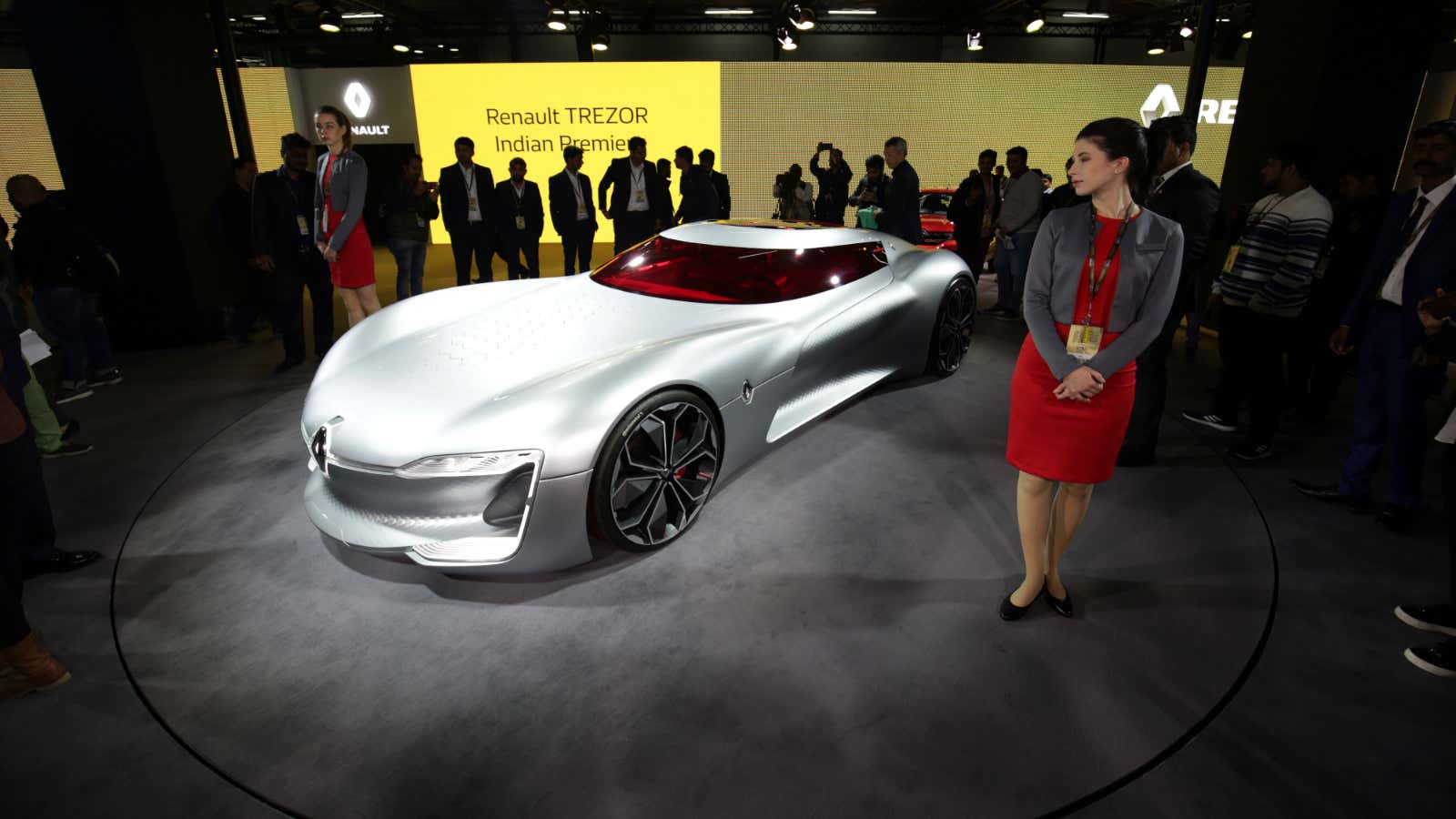Surrounded by an unruly crowd of TV cameramen, photographers, and an oddly large number of selfie-sticks, Pawan Goenka, managing director of the Mahindra & Mahindra group, spelt out the unwritten theme of the Delhi Auto Expo 2018.
“You are seeing electric vehicles everywhere,” Goenka said on Feb. 07, the day India’s largest motor show opened its doors to the media, “and clearly, this auto expo is indeed the curtain raiser for electric vehicles in India.”
Lined up metres away were six concept cars from the stable of Mahindra & Mahindra, the oldest player in India’s electric vehicle (EV) game. The company plans to develop and launch two of those six by 2019.
Across the 2.5 million square feet exhibition space, at least half-a-dozen carmakers have showcased EVs that they hope would eventually help them corner some part of India’s automotive market.
But there’s a yawning gap between the dreams they are peddling and the reality of Indian roads. This, despite the Narendra Modi government’s proclamation that all new cars sold in India after 2030 will be electric.
Too little, too soon
In a country that sells over 21 million cars every year, annual EV sales are pegged at just around 25,000 units by industry estimates. A lot of that has to do with the lack of clear policy direction.
The government was expected to unveil a national EV policy by December 2017 but that hasn’t happened. So a number of carmakers with big plans are in a limbo.
Maruti Suzuki, for instance, aims to launch its first electric car in 2020 but is yet to firm up plans and is still only in the early stages of discussions with its suppliers. “The right direction, obviously, is required,” CV Raman, Maruti Suzuki’s senior executive director of engineering, told Quartz. “The vision is there, but in terms of the ‘how,’ it needs to be worked out.”
Maruti’s closest competitor in India, Hyundai Motors, wants to launch an EV even earlier, in 2019. But the company awaits more clarity.
“Once the EV policy comes, we can frame our product policy and take a call,” Rakesh Srivastava, director for sales and marketing of Hyundai Motors India, said. ”The earlier it comes, the better it is. The government policy is the most key part, because the auto industry is large and the capital investments are high.”
A key decision the Korean carmaker will need to take is on manufacturing in India or importing EVs to be assembled locally. The former will translate into cheaper vehicles in a price-sensitive market, but the latter will be quicker to implement. The other challenge in India’s EV market is finding a balance between affordability and volume.
“The volume is too small, the space is still at the beginning of its movement,” said Guenter Butschek, managing director of Tata Motors. When, in May 2017, the Modi government decided to purchase 10,000 EVs through state-run agency Energy Efficiency Services (EESL), Tata Motors emerged as one of the two key candidates.
While it has delivered the first set of vehicles, the company hasn’t yet decided what part it wants to play in India’s EV value chain. “We need some time to look into it…to get a better idea of how fast the future is going to look different in favour of electrification.”
Ecosystem woes
However, it isn’t only about building cars as much as it is about a combination of critical factors.
“Product alone will not be enough to realise this grand vision. India will need a comprehensive ecosystem for cleaner technology including electric vehicles. (This) will include local production of components, capability for battery manufacturing, and recycling,” explained Kenichi Ayukawa, CEO of Maruti Suzuki. “Of course, we will need a bigger charging infrastructure of a scale and size that matches India’s needs.”
At the moment, carmakers are grappling with scaleability, particularly in the absence of an enabling policy regime and volumes. Some issues may not be resolved until the industry comes together.
“Infrastructure and charging, scaleability to bring the cost down when the volume goes up, and creating multiple products to meet the customer requirements are the key issues we will be working on. The first two are the challenges (towards which) we all need to work together,” said Mahesh Babu, CEO of Mahindra Electric.
His company, the first to supply electric cars for government service, has so far readied 150 units of the e-Veritos for the same, but the ecosystem is yet to adapt, he added.
Then, there are players who want the government to more aggressively support EVs. Hyundai’s Srivastava, for one, is a strong advocate of bringing in a scrappage scheme, where carmakers incentivise owners to replace older vehicles with new ones with support from the government. “The current support is not sufficient, more is required,” Srivastava said. “…it can be speeded up, by government facilitating the infrastructure and supporting affordability by way of…removing those earlier vehicles which have much older technology, and bringing in a scrappage scheme. I think customers would love it.”
So, when can you buy an affordable Indian electric car?
“It will become affordable when battery prices fall below $100 in a few years from now, for the personal segment…We believe that shared and fleet (segments) will be more affordable immediately,” Mahindra Electric’s Babu said, “and the personal segment in the longer run.”
